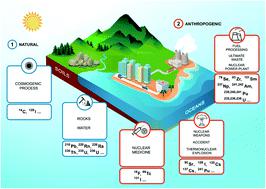当前位置:
X-MOL 学术
›
J. Anal. At. Spectrom.
›
论文详情
Our official English website, www.x-mol.net, welcomes your feedback! (Note: you will need to create a separate account there.)
Radionuclide analysis using collision–reaction cell ICP-MS technology: a review
Journal of Analytical Atomic Spectrometry ( IF 3.4 ) Pub Date : 2020-10-20 , DOI: 10.1039/d0ja00211a Silvia Diez-Fernández 1, 2, 3, 4, 5 , Hélène Isnard 1, 2, 3, 4, 5 , Anthony Nonell 1, 2, 3, 4, 5 , Carole Bresson 1, 2, 3, 4, 5 , Frédéric Chartier 1, 2, 5, 6, 7
Journal of Analytical Atomic Spectrometry ( IF 3.4 ) Pub Date : 2020-10-20 , DOI: 10.1039/d0ja00211a Silvia Diez-Fernández 1, 2, 3, 4, 5 , Hélène Isnard 1, 2, 3, 4, 5 , Anthony Nonell 1, 2, 3, 4, 5 , Carole Bresson 1, 2, 3, 4, 5 , Frédéric Chartier 1, 2, 5, 6, 7
Affiliation

|
The analysis of radionuclides (RN) is of major concern in different fields like the environment, geosciences, the nuclear industry, and medical research. Inductively coupled plasma mass spectrometry (ICP-MS) is a valuable technique for rapid and highly sensitive analysis of RN in different types of samples. Incorporating collision–reaction cells (CRC) into ICP-MS instruments is a very attractive and elegant way to overcome spectral interferences, which affects the accuracy of measurements. This paper reviews the elemental and isotopic analysis of RN using CRC technology for different types of applications including environmental studies, the nuclear industry, forensics and biological applications. The various collision–reaction cell technologies implanted in the ICP-MS instruments, are described and discussed. The different strategies based on collision–reaction mechanisms for RN analysis described in the literature are detailed element by element, including actinides (U, Pu, Am, Cm and Np), fission products (Se, Sr, Mo, Zr, I, Cs, lanthanides) and a decay product of the uranium series (Ra).
中文翻译:

使用碰撞反应池ICP-MS技术进行放射性核素分析:综述
放射性核素(RN)的分析是环境,地球科学,核工业和医学研究等不同领域的主要关注点。电感耦合等离子体质谱法(ICP-MS)是一种用于对不同类型样品中的RN进行快速且高度灵敏的分析的有价值的技术。将碰撞反应池(CRC)纳入ICP-MS仪器是克服光谱干扰(影响测量精度)的一种非常诱人且优雅的方法。本文回顾了使用CRC技术对RN进行元素和同位素分析的各种类型应用,包括环境研究,核工业,法医学和生物应用。描述和讨论了ICP-MS仪器中植入的各种碰撞反应池技术。
更新日期:2020-11-03
中文翻译:

使用碰撞反应池ICP-MS技术进行放射性核素分析:综述
放射性核素(RN)的分析是环境,地球科学,核工业和医学研究等不同领域的主要关注点。电感耦合等离子体质谱法(ICP-MS)是一种用于对不同类型样品中的RN进行快速且高度灵敏的分析的有价值的技术。将碰撞反应池(CRC)纳入ICP-MS仪器是克服光谱干扰(影响测量精度)的一种非常诱人且优雅的方法。本文回顾了使用CRC技术对RN进行元素和同位素分析的各种类型应用,包括环境研究,核工业,法医学和生物应用。描述和讨论了ICP-MS仪器中植入的各种碰撞反应池技术。



























 京公网安备 11010802027423号
京公网安备 11010802027423号